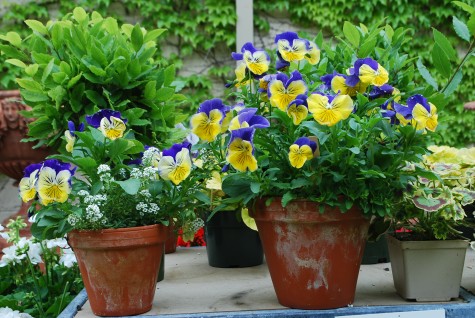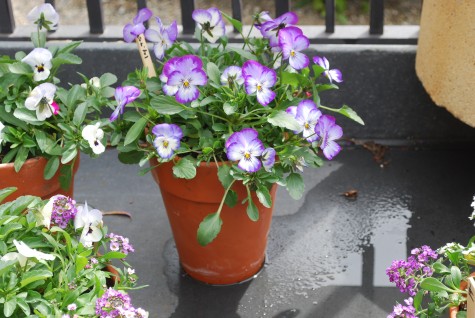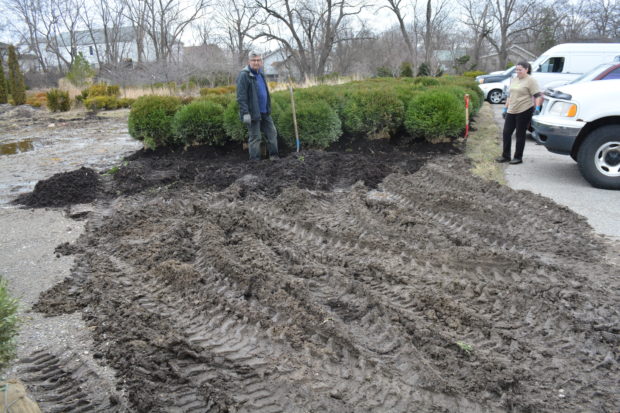 Our early spring season has been notable for its soaking and relentless rains. Daily rain. As in “don’t go out without your muck boots on” rainy. And “don’t even think of stepping into the garden” rainy. The boxwood pictured above are slated for an early landscape installation. They spent the winter indoors, in the building we use to house equipment and vehicles. By mid-March, those plants needed to come out of storage. The process was not pretty, as you can see. No gardener can tell ahead of time how the season will change from winter to spring. That transition is rarely smooth and easy. Into our second week of daily rain, the ground is simply too wet to work. We have heeled these boxwood in, not knowing when we will be able to begin planting.
Our early spring season has been notable for its soaking and relentless rains. Daily rain. As in “don’t go out without your muck boots on” rainy. And “don’t even think of stepping into the garden” rainy. The boxwood pictured above are slated for an early landscape installation. They spent the winter indoors, in the building we use to house equipment and vehicles. By mid-March, those plants needed to come out of storage. The process was not pretty, as you can see. No gardener can tell ahead of time how the season will change from winter to spring. That transition is rarely smooth and easy. Into our second week of daily rain, the ground is simply too wet to work. We have heeled these boxwood in, not knowing when we will be able to begin planting.
 These rainy days are gray and dreary. The cold is magnified by all of the water in the air. Bone chilling. I stand on the edges of my garden, knowing it is off limits right now. Stepping on the ground when it is completely saturated with water drives all of the life giving oxygen out of that soil. Compacted soil is unfriendly to any plant that is trying to grow. So how can a gardener garden early on, given these conditions? Plant some pots. The soil in containers drains much more readily than the soil underfoot. The soil of your choice loaded up in a container drains freely. Containers can be readily be planted in the rain, just ask my crews. Containers can furthermore be planted with all manner of seasonal plants that do a great job of tolerating the cold. Our trees are still leafless, and few perennial plant has dared venture forth, but for the hellebores, and the early spring flowering bulbs. What else can help soften the very early spring blues? I would suggest that a worthy preview of the spring season to come might begin with some containers confidently planted with plants that endure in spite of the cold.
These rainy days are gray and dreary. The cold is magnified by all of the water in the air. Bone chilling. I stand on the edges of my garden, knowing it is off limits right now. Stepping on the ground when it is completely saturated with water drives all of the life giving oxygen out of that soil. Compacted soil is unfriendly to any plant that is trying to grow. So how can a gardener garden early on, given these conditions? Plant some pots. The soil in containers drains much more readily than the soil underfoot. The soil of your choice loaded up in a container drains freely. Containers can be readily be planted in the rain, just ask my crews. Containers can furthermore be planted with all manner of seasonal plants that do a great job of tolerating the cold. Our trees are still leafless, and few perennial plant has dared venture forth, but for the hellebores, and the early spring flowering bulbs. What else can help soften the very early spring blues? I would suggest that a worthy preview of the spring season to come might begin with some containers confidently planted with plants that endure in spite of the cold.
These branchy style cut pussy willow stems speak to and echo the spring garden. Pussy willow is a very large growing shrub that blooms very early. If your landscape is not large enough to accommodate this big rangy shrub, the cut branches look terrific in spring containers. The blue preserved and dyed eucalyptus acknowledges that blue color that is so beautiful and reminiscent of our spring. Pansies and violas are entirely cold hardy right out of the flat, provided they have been grown in cold conditions.
 We buy pansies and violas that were started from seed last summer. They are over wintered in houses with no heat. They are ready for the April chill. If the temperature threatened to go below 25 overnight I would cover them. If I wanted to protect their blooms from a windy 28 degree night, I would cover them. This seems like a call to plant away to me. Pansies and violas are among some of the most charming, sparkly, and cheery plants that endow our northern tier spring season. I would not do without them.
We buy pansies and violas that were started from seed last summer. They are over wintered in houses with no heat. They are ready for the April chill. If the temperature threatened to go below 25 overnight I would cover them. If I wanted to protect their blooms from a windy 28 degree night, I would cover them. This seems like a call to plant away to me. Pansies and violas are among some of the most charming, sparkly, and cheery plants that endow our northern tier spring season. I would not do without them.
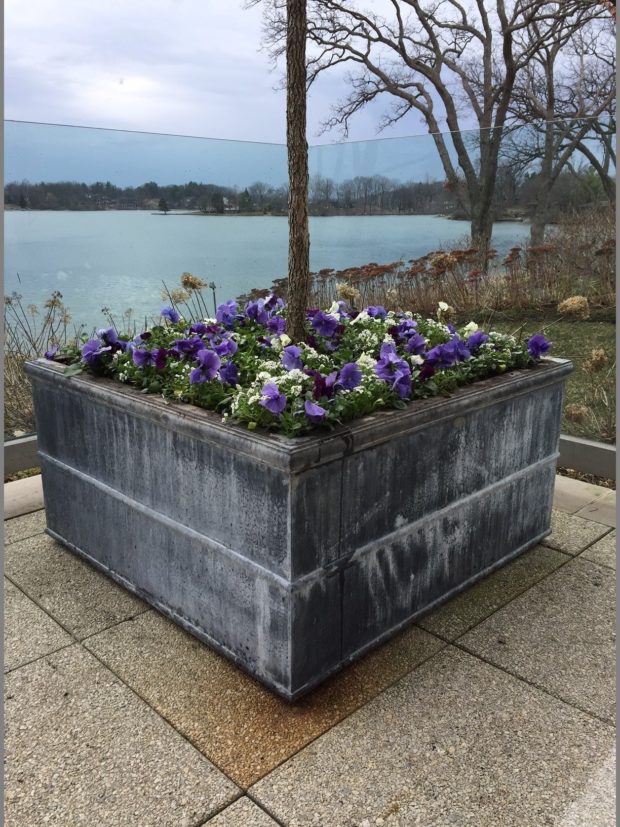 Planting in cold blustery weather is not my favorite, but I am ready for spring. So I plant anyway. This large container is home to a Turkish hazel tree – corylus corlurna. It survived the winter in this container, and threw out scads of long pink catkins a week ago. Bravo! We planted the ground level soil with an overall mix of blue and purple/blue bicolor pansies and white alyssum. In several weeks, when the filbert tree leafs out, this container planting will sing spring.
Planting in cold blustery weather is not my favorite, but I am ready for spring. So I plant anyway. This large container is home to a Turkish hazel tree – corylus corlurna. It survived the winter in this container, and threw out scads of long pink catkins a week ago. Bravo! We planted the ground level soil with an overall mix of blue and purple/blue bicolor pansies and white alyssum. In several weeks, when the filbert tree leafs out, this container planting will sing spring.
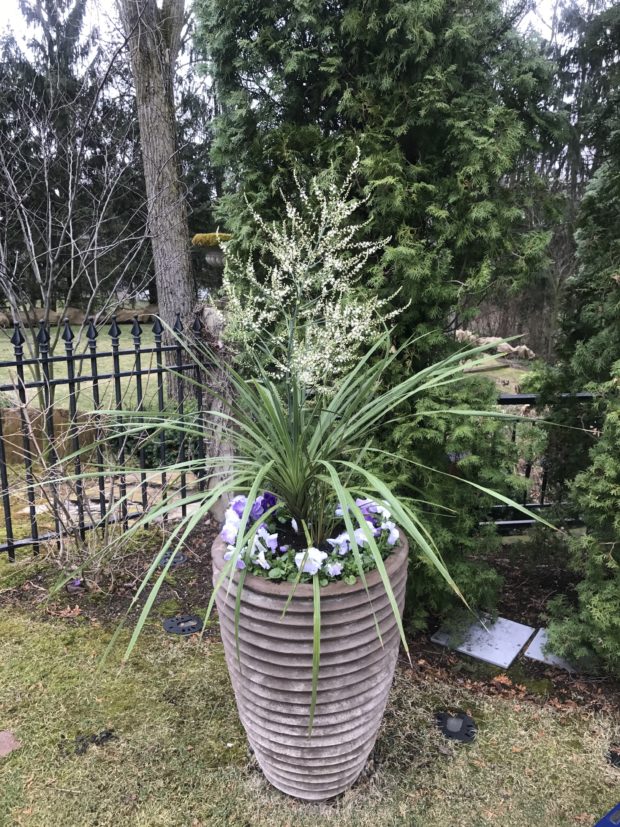 Have you ever seen a spike bloom? Me neither. This particular spike was planted in this client’s container last summer. I wintered the plant over in a greenhouse. I was faint with surprise when we went to pick up that spike for her spring garden. Planted in this container, there is an incredibly beautiful and fragrant bloom spike that takes all of the visual attention away from a landscape that has not yet emerged. The pale lavender pansies will grow and spill over the edges. Are spikes cold tolerant? Utterly.
Have you ever seen a spike bloom? Me neither. This particular spike was planted in this client’s container last summer. I wintered the plant over in a greenhouse. I was faint with surprise when we went to pick up that spike for her spring garden. Planted in this container, there is an incredibly beautiful and fragrant bloom spike that takes all of the visual attention away from a landscape that has not yet emerged. The pale lavender pansies will grow and spill over the edges. Are spikes cold tolerant? Utterly.
 This is a favorite spring container, just planted a few days ago. The fat and fuzzy cut pussy willow branches preside over all. A cream/green preserved eucalyptus provides some mid level interest, and subtle color. The box is stuffed full of a white pansy with a purple blotch, beautifully grown and just about ready to come in to bloom. The spring gardening season is all about hope, delight, and renewal. The garden coming to life again – what could be better? The very early spring container planting season gives any gardener a chance to whoop up the coming of spring. I like how this spring container addresses that moment.
This is a favorite spring container, just planted a few days ago. The fat and fuzzy cut pussy willow branches preside over all. A cream/green preserved eucalyptus provides some mid level interest, and subtle color. The box is stuffed full of a white pansy with a purple blotch, beautifully grown and just about ready to come in to bloom. The spring gardening season is all about hope, delight, and renewal. The garden coming to life again – what could be better? The very early spring container planting season gives any gardener a chance to whoop up the coming of spring. I like how this spring container addresses that moment.
 This big container features pansies, alyssum, and lettuce underneath a centerpiece of cut pussy willow and tiger branches. Lettuce is a chilly weather vegetable, but it will wither in extreme cold. Pots planted with lettuce now will need to be covered when the night temperatures go low. I suspect the same is true for myrtle topiaries. I will confess that I have a habit of pushing the limits of plants to tolerate cold in our early spring. But my best friend in the early spring is floating row cover. Vegetable gardeners cover their early transplants with this non woven fabric to protect them from the cold. I use it to protect my early spring container plantings facing a fiercely cold night. Floating row cover keeps the temperature underneath that cover 10 degrees higher than the air temperature.
This big container features pansies, alyssum, and lettuce underneath a centerpiece of cut pussy willow and tiger branches. Lettuce is a chilly weather vegetable, but it will wither in extreme cold. Pots planted with lettuce now will need to be covered when the night temperatures go low. I suspect the same is true for myrtle topiaries. I will confess that I have a habit of pushing the limits of plants to tolerate cold in our early spring. But my best friend in the early spring is floating row cover. Vegetable gardeners cover their early transplants with this non woven fabric to protect them from the cold. I use it to protect my early spring container plantings facing a fiercely cold night. Floating row cover keeps the temperature underneath that cover 10 degrees higher than the air temperature.
 What plants tolerate a cold container environment? Pansies and violas, for sure. Dusty miller. Spikes. Alyssum. Chicago figs. Rosemary and lavender, cold grown. Ivy will take some cold. Chard, parsley, chervil and thyme shrug off the cold. Early spring flowering bulbs are great in containers. Think daffodils. Hellebores are so beautiful in early spring pots. Once that spring pot fades, those hellebores can be transplanted into the garden. Osteos. Marguerites. Interested in planting early spring containers? Try everything. There will be some successes, and some failures. Any gardener can handle and be energized by these odds.
What plants tolerate a cold container environment? Pansies and violas, for sure. Dusty miller. Spikes. Alyssum. Chicago figs. Rosemary and lavender, cold grown. Ivy will take some cold. Chard, parsley, chervil and thyme shrug off the cold. Early spring flowering bulbs are great in containers. Think daffodils. Hellebores are so beautiful in early spring pots. Once that spring pot fades, those hellebores can be transplanted into the garden. Osteos. Marguerites. Interested in planting early spring containers? Try everything. There will be some successes, and some failures. Any gardener can handle and be energized by these odds.
 Spring is on the way. So excited. Am I ready? Yes I am.
Spring is on the way. So excited. Am I ready? Yes I am.





